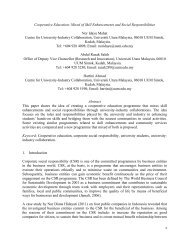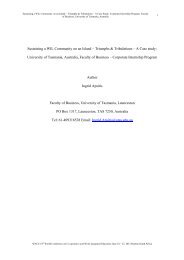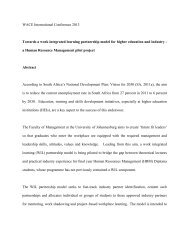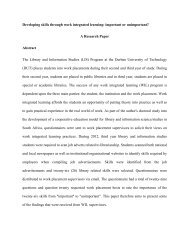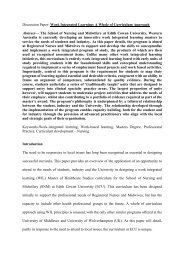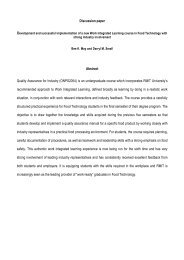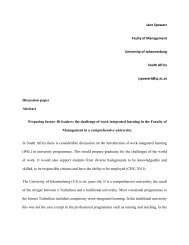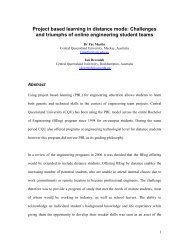Assessing the effectiveness of co-op education in Japan -A ... - WACE
Assessing the effectiveness of co-op education in Japan -A ... - WACE
Assessing the effectiveness of co-op education in Japan -A ... - WACE
Create successful ePaper yourself
Turn your PDF publications into a flip-book with our unique Google optimized e-Paper software.
<strong>Assess<strong>in</strong>g</strong> <strong>the</strong> <strong>effectiveness</strong> <strong>of</strong> <strong>co</strong>-<strong>op</strong> <strong>education</strong> <strong>in</strong> <strong>Japan</strong><br />
-A panel data analysis at KSU-<br />
Pr<strong>of</strong>essor Masashi Matsutaka<br />
Center <strong>of</strong> Research and Devel<strong>op</strong>ment for Co<strong>op</strong>erative Education<br />
Pr<strong>of</strong>essor Yasushi Tanaka<br />
Faculty <strong>of</strong> E<strong>co</strong>nomics & Center <strong>of</strong> Research and Devel<strong>op</strong>ment for Co<strong>op</strong>erative Education<br />
Paul Churton<br />
Career <strong>education</strong> program <strong>co</strong>ord<strong>in</strong>ator Center for International Programs<br />
Kyoto Sangyo University<br />
Abstract<br />
The recently observed high university enrolment rate <strong>of</strong> over 50% <strong>in</strong> <strong>Japan</strong> questions <strong>the</strong> higher<br />
<strong>education</strong>’s orthodox role <strong>of</strong> nurtur<strong>in</strong>g <strong>the</strong> nation’s future elite leaders. Instead, it seems to serve <strong>the</strong><br />
society more effectively through rais<strong>in</strong>g <strong>the</strong> general standard <strong>of</strong> nation’s work force. Consequently,<br />
as elsewhere <strong>in</strong> <strong>the</strong> world, generic or s<strong>of</strong>t skills have be<strong>co</strong>me <strong>the</strong> key words <strong>in</strong> <strong>Japan</strong>, and <strong>the</strong><br />
<strong>co</strong>ncept <strong>of</strong> “<strong>co</strong><strong>op</strong>erative <strong>education</strong> (or better known as ‘career <strong>education</strong>’ <strong>in</strong> <strong>Japan</strong>)” is earn<strong>in</strong>g<br />
grow<strong>in</strong>g p<strong>op</strong>ularity among those seek<strong>in</strong>g this new role <strong>of</strong> higher <strong>education</strong><br />
The present paper (1) looks at how students see career <strong>education</strong>, (2) evaluates it and (3)<br />
discusses how we can improve it, by analyz<strong>in</strong>g students’ survey data. Over 1300 students answered<br />
<strong>the</strong> two sets <strong>of</strong> surveys at Kyoto Sangyo University --- at <strong>the</strong> beg<strong>in</strong>n<strong>in</strong>g <strong>of</strong> <strong>the</strong> undergraduate<br />
program and <strong>in</strong> <strong>the</strong> 4 th and f<strong>in</strong>al year. We traced <strong>the</strong> students dur<strong>in</strong>g his/her university career, to<br />
see what expectation <strong>the</strong>y had at <strong>the</strong> entry, how <strong>the</strong>y spent <strong>the</strong>ir undergraduate years and what<br />
<strong>the</strong>y earned at <strong>the</strong> exit for <strong>the</strong> job placement. We also set questionnaire to a limited number <strong>of</strong><br />
alumni <strong>of</strong> our <strong>in</strong>tensive career <strong>education</strong> programs for <strong>the</strong>ir feedback about its <strong>effectiveness</strong> on <strong>the</strong>ir<br />
career.<br />
Our method and approach can easily be applied <strong>in</strong> o<strong>the</strong>r <strong>co</strong>untries to streng<strong>the</strong>n <strong>the</strong>ir <strong>co</strong><strong>op</strong>erative<br />
<strong>education</strong> programs. Interest<strong>in</strong>gly, our f<strong>in</strong>d<strong>in</strong>g seems to suggest that an emphasis on academic<br />
study is <strong>the</strong> most efficient way to devel<strong>op</strong> generic skills and thus <strong>the</strong> most effective <strong>co</strong>-<strong>op</strong> <strong>education</strong>.<br />
Introduction<br />
Co-<strong>op</strong> Education (better known as Career Education <strong>in</strong> <strong>Japan</strong> and call it henceforth) was first
<strong>in</strong>itiated <strong>in</strong> <strong>Japan</strong>ese higher <strong>education</strong> approximately 10 years ago with <strong>the</strong> M<strong>in</strong>istry <strong>of</strong> Education’s<br />
<strong>in</strong>troduction <strong>of</strong> <strong>the</strong> <strong>co</strong>ncept <strong>in</strong> <strong>the</strong> Report <strong>of</strong> Central Educational Council titled “On <strong>the</strong> better<br />
relation between primary and se<strong>co</strong>ndary <strong>education</strong> and higher <strong>education</strong>” <strong>in</strong> 1999. It has spread<br />
rapidly ever s<strong>in</strong>ce but <strong>in</strong>formation on <strong>the</strong> current situation is ra<strong>the</strong>r limited with <strong>in</strong>sufficient<br />
accumulation <strong>of</strong> empirical research as well as lack <strong>of</strong> devel<strong>op</strong>ment <strong>in</strong> methods for measur<strong>in</strong>g and<br />
evaluat<strong>in</strong>g <strong>education</strong>al effects.<br />
Beh<strong>in</strong>d this gap was <strong>the</strong> unexpectedly rapid change <strong>of</strong> 1990’s <strong>Japan</strong> <strong>in</strong> <strong>the</strong> socioe<strong>co</strong>nomic<br />
environment for <strong>the</strong> young work force <strong>in</strong> two ways. First, <strong>co</strong>mpanies began to f<strong>in</strong>d that <strong>the</strong> young<br />
work force was not equipped with sufficient basic occupational or generic skills, which is <strong>the</strong> issue<br />
for <strong>the</strong> career <strong>education</strong> programs to tackle. Se<strong>co</strong>nd, a grow<strong>in</strong>g number <strong>of</strong> students were f<strong>in</strong>d<strong>in</strong>g it<br />
difficult to motivate <strong>the</strong>mselves, which is <strong>the</strong> issue for <strong>the</strong> first year experience programs to tackle..<br />
Because <strong>the</strong> two changes came toge<strong>the</strong>r <strong>the</strong> research is fall<strong>in</strong>g beh<strong>in</strong>d <strong>the</strong> devel<strong>op</strong>ment.<br />
For <strong>the</strong> devel<strong>op</strong>ment <strong>of</strong> career <strong>education</strong>, empirical research with appr<strong>op</strong>riate analytical methods<br />
is essential. In particular, it would help our young work force hold a positive attitude toward work<br />
and acquire generic skills. In l<strong>in</strong>e with this, <strong>the</strong> objective <strong>of</strong> our research is to provide resources for<br />
mak<strong>in</strong>g <strong>the</strong> current career <strong>education</strong> more effective.<br />
Methodology<br />
The analytical framework follows three steps. The first step is to clarify what <strong>in</strong>fluence <strong>the</strong><br />
students’ traits such as awareness and attitude at <strong>the</strong> time <strong>of</strong> enter<strong>in</strong>g university can have on <strong>the</strong>ir<br />
career choices and job hunt<strong>in</strong>g activities <strong>in</strong> particular. The se<strong>co</strong>nd step is to identify, if <strong>the</strong> <strong>in</strong>fluence<br />
exists, what k<strong>in</strong>d <strong>of</strong> awareness and attitudes <strong>the</strong>y are And <strong>the</strong> third step is to suggest <strong>the</strong> type <strong>of</strong><br />
<strong>education</strong> universities should provide.<br />
Data was taken from two panel data surveys targeted at students <strong>of</strong> Kyoto Sangyo University.<br />
The first survey was held when student’s entered university <strong>in</strong> April, 2002 and <strong>the</strong> o<strong>the</strong>r was held <strong>in</strong>
October, 2006 when <strong>the</strong> same students were <strong>in</strong> <strong>the</strong> 4 th and f<strong>in</strong>al year. A longitud<strong>in</strong>al data set <strong>of</strong> 1345<br />
was created by <strong>co</strong>rrespond<strong>in</strong>g students’ names and identity numbers <strong>of</strong> <strong>the</strong> two surveys. As it was<br />
not possible to clarify <strong>the</strong> number <strong>of</strong> survey sheets which were distributed for each survey, exact<br />
calculation <strong>of</strong> percentages <strong>of</strong> responses was also not possible. However as <strong>the</strong> survey was<br />
fundamentally targeted at all students <strong>in</strong> those years, tak<strong>in</strong>g that number <strong>of</strong> students as <strong>the</strong> surveyed<br />
p<strong>op</strong>ulation would give <strong>the</strong> estimated re<strong>co</strong>very rate <strong>of</strong> 37%.<br />
Data ga<strong>the</strong>red <strong>in</strong> this research was a set <strong>of</strong> multiple variables based on <strong>the</strong> subjective judgments<br />
<strong>of</strong> students. Typically, <strong>the</strong> data <strong>co</strong>llected <strong>in</strong> university <strong>education</strong> as an atta<strong>in</strong>ment measure are<br />
objective variables on achievement levels <strong>of</strong> knowledge and technical skill and not <strong>the</strong> subjective<br />
variables <strong>of</strong> <strong>the</strong> student’s awareness and attitude. A reason for this was <strong>the</strong> question <strong>of</strong> whe<strong>the</strong>r <strong>the</strong><br />
personal awareness and attitude <strong>of</strong> students can be measured objectively among <strong>the</strong> different<br />
<strong>in</strong>dividuals. Fur<strong>the</strong>rmore, it is anticipated that students’ awareness and attitude may be more<br />
<strong>in</strong>fluenced by extracurricular activities such as club and circles, and part-time jobs than regular<br />
classes. And <strong>the</strong> greater <strong>the</strong> <strong>in</strong>fluence <strong>of</strong> extracurricular activities be<strong>co</strong>mes, <strong>the</strong> more difficult it is<br />
for <strong>the</strong> university to <strong>in</strong>tervene structurally and systematically and <strong>the</strong> nearer <strong>the</strong> university reaches<br />
to its limits <strong>of</strong> <strong>co</strong>ntribution to improve university <strong>education</strong>.<br />
Even if knowledge and technical skills are assigned as <strong>education</strong>al targets, <strong>the</strong>re is no problem if<br />
<strong>the</strong> relationship between university <strong>education</strong> and work<strong>in</strong>g career is strong. However, at least <strong>in</strong><br />
<strong>Japan</strong> at <strong>the</strong> present, <strong>the</strong>re seems to be no smooth transition from <strong>the</strong> knowledge and technical skills<br />
atta<strong>in</strong>ed through university <strong>education</strong> to those required at work. For this reason, us<strong>in</strong>g traits <strong>of</strong><br />
awareness and attitude as an atta<strong>in</strong>ment measure for university <strong>education</strong> is extremely important.<br />
Giv<strong>in</strong>g attention to traits <strong>of</strong> awareness and attitude is also important as a university strategy. As<br />
long as <strong>the</strong> emphasis is on fundamental academic ability such as knowledge and technical skills,<br />
students’ successful devel<strong>op</strong>ment at university would be ma<strong>in</strong>ly dependent on <strong>the</strong>ir academic<br />
read<strong>in</strong>ess before university admission, which is unrelated to awareness and attitude. For this reason,
should a relationship between particular attitude traits and study or job seek<strong>in</strong>g atta<strong>in</strong>ments be<strong>co</strong>me<br />
evident, universities can <strong>co</strong>nsider not only academic ability, but also <strong>the</strong>se traits as selection criteria<br />
at <strong>the</strong> time <strong>of</strong> admission. There is evidence that, although slow, such movement is already tak<strong>in</strong>g<br />
place. Especially <strong>in</strong> universities which are unable to select new students on academic ability,<br />
students are admitted based on <strong>the</strong>se traits. Devel<strong>op</strong><strong>in</strong>g <strong>the</strong>se traits fur<strong>the</strong>rmore <strong>co</strong>uld improve <strong>the</strong><br />
employment prospect <strong>of</strong> <strong>the</strong> students. In this sense, it is worthwhile to <strong>co</strong>nsider devel<strong>op</strong><strong>in</strong>g <strong>of</strong><br />
attitude traits as one <strong>of</strong> <strong>the</strong> important atta<strong>in</strong>ment measure <strong>of</strong> university <strong>education</strong>.<br />
Results and Discussion<br />
The students were asked about <strong>the</strong>ir awareness and attitude twice --- <strong>in</strong> <strong>the</strong> first year when <strong>the</strong>y<br />
entered university and <strong>in</strong> <strong>the</strong> fourth and f<strong>in</strong>al year <strong>of</strong> university career. And <strong>the</strong> follow<strong>in</strong>g are <strong>the</strong><br />
five ma<strong>in</strong> results.<br />
First, students were asked about <strong>the</strong>ir ma<strong>in</strong> <strong>in</strong>terests <strong>in</strong> university life. In <strong>the</strong> first year <strong>the</strong>y were<br />
asked about <strong>the</strong>ir <strong>in</strong>terests and <strong>in</strong> <strong>the</strong> fourth year <strong>the</strong>y had to answer whe<strong>the</strong>r <strong>the</strong>y were able to<br />
ma<strong>in</strong>ta<strong>in</strong> <strong>the</strong> <strong>in</strong>terests. The <strong>in</strong>terest list <strong>in</strong>cluded academic study, obta<strong>in</strong><strong>in</strong>g qualifications, club<br />
activities, build<strong>in</strong>g friendships and part time job for extra <strong>in</strong><strong>co</strong>me. The responses were categorized<br />
<strong>in</strong>to four groups: (1) those ma<strong>in</strong>ta<strong>in</strong>ed <strong>the</strong> high motivation (2) those raised motivation (3) those<br />
dr<strong>op</strong>ped motivation (4) those with low motivation throughout. It was found that; (a) for academic<br />
study, 60% <strong>of</strong> <strong>the</strong> students succeeded <strong>in</strong> ma<strong>in</strong>ta<strong>in</strong><strong>in</strong>g <strong>the</strong> high motivation, (b) for obta<strong>in</strong><strong>in</strong>g<br />
qualification, 60% <strong>of</strong> <strong>the</strong>m dr<strong>op</strong>ped motivation, and (c) for friendships, 80% <strong>of</strong> <strong>the</strong>m managed to<br />
ma<strong>in</strong>ta<strong>in</strong> <strong>the</strong> <strong>in</strong>terest over <strong>the</strong> four years. However, with a ris<strong>in</strong>g university enrolment rate, we might<br />
see less <strong>of</strong> those en<strong>co</strong>urag<strong>in</strong>g figures and it would be <strong>the</strong> university’s task to provide <strong>the</strong>m <strong>the</strong><br />
student- friendly environment.<br />
Se<strong>co</strong>nd, <strong>the</strong> students were asked about <strong>the</strong>ir <strong>in</strong>terest <strong>in</strong> academic programs. The question asked<br />
whe<strong>the</strong>r <strong>the</strong>y entered <strong>the</strong> university with specific academic purpose such as <strong>the</strong>re are lectures <strong>of</strong>
<strong>in</strong>terest, good language program, good IT program, small class teach<strong>in</strong>g, well known academic<br />
staffs, extended qualification program. 69% <strong>of</strong> <strong>the</strong> respondents came with one <strong>of</strong> <strong>the</strong> specific<br />
reasons above, while 31% <strong>co</strong>uld not mention any. It is en<strong>co</strong>urag<strong>in</strong>g to know that <strong>of</strong> <strong>the</strong> former,<br />
65.3% managed to keep <strong>the</strong> motivation high till <strong>the</strong> end. Even more so is <strong>the</strong> result that <strong>the</strong> 50.1%<br />
<strong>of</strong> <strong>the</strong> latter decided to ma<strong>in</strong>ta<strong>in</strong> <strong>the</strong> academic <strong>in</strong>terest despite start<strong>in</strong>g <strong>the</strong> university program<br />
without strong motivation. The result suggests that a <strong>co</strong>nsiderable pr<strong>op</strong>ortion <strong>of</strong> <strong>the</strong> students <strong>co</strong>me<br />
with no clear focus but by giv<strong>in</strong>g right advice <strong>the</strong>y can f<strong>in</strong>d <strong>the</strong> focus.<br />
Third, <strong>the</strong> students were asked about <strong>the</strong>ir desirable and actual career path. The desirable career<br />
paths are categorized <strong>in</strong>to six; (1) private sector with specific <strong>in</strong>dustry and occupation, (2) private<br />
sector <strong>in</strong> general, (3) civil service or teach<strong>in</strong>g, (4) graduate school, (5) no plan yet and (6) o<strong>the</strong>rs.<br />
As for <strong>the</strong> actual career path, <strong>the</strong>re are seven choices; (a) full time <strong>in</strong> private sector, (b) fixed<br />
<strong>co</strong>ntract <strong>in</strong> private sector, (c) full time <strong>in</strong> civil service or teach<strong>in</strong>g, (d) part time <strong>in</strong> civil service or<br />
teach<strong>in</strong>g, (e) self-employment, (f) part time job, (g) vocational school (h) graduate school, (i)<br />
repeat<strong>in</strong>g <strong>the</strong> year, (j) still look<strong>in</strong>g (k) o<strong>the</strong>rs. Several <strong>in</strong>terest<strong>in</strong>g observations can be made. First,<br />
among those who are still look<strong>in</strong>g for a job (i.e. 201 students), <strong>the</strong> pr<strong>op</strong>ortion <strong>of</strong> those who had<br />
specific plans i.e. (1) represented relatively smaller group (10.4%)than those who did not have<br />
specific plan i.e. (2) (26.4%) This implies that if you <strong>co</strong>me to university with a focused career path,<br />
you are more likely to f<strong>in</strong>d one quickly. At <strong>the</strong> same time, 22.9% <strong>of</strong> those still look<strong>in</strong>g for a job<br />
started <strong>of</strong>f with no plan (i.e. (5)) at <strong>the</strong> entry. It may be necessary to support those students<br />
throughout <strong>the</strong> undergraduate program.<br />
Fourth, possible factors <strong>in</strong>fluenc<strong>in</strong>g a successful job <strong>of</strong>fer were sought us<strong>in</strong>g a regression analysis.<br />
Dependent variable is <strong>the</strong> actual job <strong>of</strong>fer and is 1 if he/she has none and 0 o<strong>the</strong>rwise, while<br />
<strong>in</strong>dependent variables are students’ characteristics such as sex and faculty and <strong>the</strong>ir awareness and<br />
attitude as has been used so far at <strong>the</strong> entry. There are two <strong>in</strong>dependent variables with positive<br />
significance --- academic study and desirable career path. The implication is that you are more
likely to receive a job <strong>of</strong>fer if you are focused <strong>in</strong> academic study and well as future career.<br />
Conclusions<br />
To <strong>co</strong>nclude <strong>the</strong> paper, <strong>the</strong>re are three po<strong>in</strong>ts to be learned from our research.<br />
First, it is <strong>the</strong> significance <strong>of</strong> “study at university.” The survey question did not directly ask<br />
students what k<strong>in</strong>d <strong>of</strong> knowledge and technical skills <strong>the</strong>y specifically atta<strong>in</strong>ed through study at<br />
university. However, <strong>the</strong> survey did ask questions about “will<strong>in</strong>gness to make effort to achieve<br />
someth<strong>in</strong>g <strong>in</strong> university life” at <strong>the</strong> entry, and whe<strong>the</strong>r “<strong>the</strong>y did actually succeed it with<br />
enthusiasm” <strong>in</strong> <strong>the</strong> 4 th<br />
year, And <strong>the</strong> result shows that those who were satisfied with <strong>the</strong>ir<br />
self-evaluation and thus s<strong>co</strong>red high <strong>in</strong> <strong>the</strong>se questions about <strong>the</strong>mselves also were do<strong>in</strong>g well <strong>in</strong> job<br />
seek<strong>in</strong>g, which start as early as <strong>in</strong> <strong>the</strong> 4 th year even before graduation <strong>in</strong> <strong>Japan</strong>. It is be<strong>co</strong>m<strong>in</strong>g a<br />
ma<strong>in</strong> stream <strong>in</strong> career <strong>education</strong> to start programs <strong>in</strong> <strong>the</strong> 1 st year and <strong>co</strong>nt<strong>in</strong>ue through <strong>in</strong>to 3 rd and<br />
4 th years when <strong>the</strong> students start job search activities. It is understood that <strong>the</strong> students’ quality that<br />
career <strong>education</strong> attempts to nurture such as focused view on career and ability to adjust to social<br />
environment are go<strong>in</strong>g to <strong>in</strong>fluence <strong>the</strong>ir future employment prospect <strong>in</strong> <strong>the</strong> early part <strong>of</strong> university<br />
career through stimulat<strong>in</strong>g <strong>the</strong>ir study at university. In o<strong>the</strong>r words, through career <strong>education</strong>,<br />
br<strong>in</strong>g<strong>in</strong>g some pr<strong>of</strong>essional relevance to ‘academic study’ motivate <strong>the</strong> students.<br />
The se<strong>co</strong>nd po<strong>in</strong>t is a word <strong>of</strong> caution about <strong>the</strong> way we analyze <strong>the</strong> <strong>education</strong>al atta<strong>in</strong>ment <strong>of</strong><br />
career <strong>education</strong>. The way questions are set can simply change <strong>the</strong> way students answer. As with<br />
our surveys, if <strong>the</strong> method is dependent on <strong>the</strong> students’ subjective judgment, ask<strong>in</strong>g if <strong>the</strong>y have<br />
reached <strong>the</strong>ir own target is not <strong>the</strong> same th<strong>in</strong>g as ask<strong>in</strong>g whe<strong>the</strong>r <strong>the</strong>y have reached <strong>the</strong> university’s<br />
target. Fur<strong>the</strong>rmore, it is important to note that tim<strong>in</strong>g <strong>of</strong> survey <strong>co</strong>ld affect <strong>the</strong> response.<br />
The third po<strong>in</strong>t is when <strong>co</strong>nsider<strong>in</strong>g how to set up a measure <strong>of</strong> <strong>education</strong>al atta<strong>in</strong>ment, it is<br />
necessary to be well <strong>in</strong>formed about <strong>the</strong> awareness and attitude <strong>of</strong> students at <strong>the</strong> entry. Ac<strong>co</strong>rd<strong>in</strong>g<br />
to <strong>the</strong> I-E-O (Input-Environment-Output) model devel<strong>op</strong>ed by Alexander Ast<strong>in</strong>, Found<strong>in</strong>g Director
<strong>of</strong> <strong>the</strong> Higher Education Research Institute at UCLA, atta<strong>in</strong>ments (Output) are not simply results <strong>of</strong><br />
<strong>the</strong> Environment, but by analyz<strong>in</strong>g how much <strong>the</strong> prior background (Input) affected <strong>the</strong>m, it is<br />
possible to measure <strong>the</strong> exact effects from <strong>the</strong> environmental factors. (Austn (2002)) Often, when<br />
measur<strong>in</strong>g <strong>education</strong>al atta<strong>in</strong>ments, <strong>the</strong>re is a focus on <strong>the</strong>ir relationship to <strong>the</strong> environmental<br />
factors only. However, it is evident that not only environmental factors but also students’ own<br />
nature and background can have an <strong>in</strong>fluence. Therefore it is crucial to understand <strong>the</strong> students’<br />
traits <strong>of</strong> awareness and attitude at <strong>the</strong> university entry.<br />
We would like to end <strong>the</strong> paper by add<strong>in</strong>g some <strong>co</strong>mments on an extra follow-up survey carried<br />
out after <strong>the</strong> previously survey students had graduated. The graduates <strong>in</strong>dicated that experiences<br />
which were useful for <strong>the</strong>m <strong>in</strong> select<strong>in</strong>g <strong>the</strong>ir career came not only from programs <strong>in</strong> <strong>the</strong> university<br />
curriculum, but also through <strong>in</strong>ternships and varied experiences with<strong>in</strong> <strong>the</strong>ir student lives. The<br />
abilities nurtured through <strong>the</strong>se activities were <strong>of</strong>ten <strong>co</strong>nsistent with those valued by <strong>co</strong>mpanies. It<br />
is thought that even better <strong>education</strong>al atta<strong>in</strong>ments can be made by clearer understand<strong>in</strong>g <strong>of</strong> what<br />
abilities are necessary for <strong>the</strong> vocational p<strong>op</strong>ulation and devel<strong>op</strong><strong>in</strong>g an <strong>education</strong> program which<br />
relates with this.<br />
References<br />
Ast<strong>in</strong>, A.W., Oseguera, L., Sax, L. J., & Korn, W.S. (2002). The American Freshman: Thirty-Five<br />
Year Trends. Higher Education Research Institute, UCLA. Los Angeles, California.<br />
Kuzuki, K. (2006). The Student Perspectives on <strong>the</strong> Quality <strong>of</strong> University Education. In COE<br />
Publication Series, 18, 55-70. Research Institute for Higher Education, Hiroshima<br />
University.<br />
Ogata, N. (1997). Higher Education and Labor Market <strong>in</strong> <strong>Japan</strong>; Reviews <strong>of</strong> Studies s<strong>in</strong>ce 1990 and<br />
Future Prospects - Research In Higher Education (pp.239-250). Research Institute for<br />
Higher Education, Hiroshima University.
Matsutaka, M. (2008). University Pr<strong>op</strong>elled Career Education. Acta Humanistica et Scientifica<br />
Uniersitatis Sangio Kyototiensis Social Science Series, 25, 145-168. Kyoto Sangyo<br />
University.



